Introduction
Body and trace fossils represent a unique legacy of the biosphere through time. It is estimated that only a small portion of life can be preserved as fossils in the rocks (e.g., Bryson 2003). Fossil remains can be incomplete, disarticulated, deformed by diagenesis, recrystallized by various chemical processes through their burial history, and can be transported away from their place of deposition. For all these reasons, each fossil can tell an incredible story of the ancient past. Modern investigation techniques can release incredible details about the age of the fossils, the ancient environments in which the organism lived, and the location on Earth allowing for continental drift. Likewise, the rocks can tell us a great deal of information about ancient habitats and climates. In exceptional cases, the combination of geodiversity of rocks and fossils in one place can reveal a fascinating story spanning through millions of years and over several environments.
The Beigua Unesco Global Geopark (Beigua UGGp) in Liguria, NW Italy (Fig. 1) fulfills all these expectations, as it exhibits a remarkable geodiversity (rocks, fossils and landscapes) and it is a relevant study area to understand the Ligurian Alps (south-eastern termination of Western Alps) as well as the structural and metamorphic evolution of the Ligurian-Piemontese ocean.
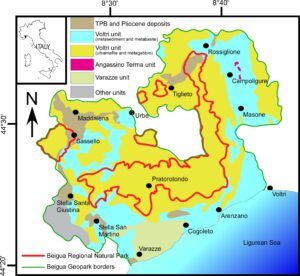
Figure 1. Geological map of the Beigua Geopark with location of the SSG and MPP geosites.
The rock exposures show different geological times from both the Mesozoic and the Cenozoic, a broad range of ancient environments from continental settings to fully marine and reefal conditions, and passing through all sorts of transitional facies characterized by rivers, lakes and swamps. The sedimentary record also preserves evidence of a time when there was major global warming and the impact of that warming on life can be studied.
Here, we highlight two of the most important outcrops in the Beigua UGGp, the Stella Santa Giustina (SSG) and Maddalena–Ponte Prina (MPP) geosites. The role of Beigua UGGp in preserving geoheritage and in enhancing and promoting knowledge through specific strategies, such as a dedicated visitor center, guided tours along the geotrails, and close collaboration with nearby university researchers plays a pivotal role in maintaining high operational standards.
Geological Setting and Geosite Description
The geology of the Beigua UGGp area (Fig. 1) is dominated by the Voltri tectono-metamorphic unit (meta-ophiolites and related metasediments and slices of subcontinental lithospheric mantle) and the late- to post-orogenic sedimentary successions of the Tertiary Piedmont Basin (TPB, nonmarine to shallow marine, fine to coarse siliciclastic deposits and local reef limestone). For detailed information about the geology of the study area, the reader may refer to Lorenz (1969), Capponi & Giammarino (1982), Gelati & Gnaccolini (1988), Bernini & Zecca (1990), Mutti et al. (1995), Giglia et al. (1996), Capponi et al. (2001, 2009, 2013, 2016), Quaranta et al. (2009a, b), Bonci et al. (2011, 2018), Federico et al. (2014, 2015), and reference therein. The sedimentary rocks of the TPB in the Beigua UGGp area record an Oligocene pre-transgressive to transgressive depositional history and include well-preserved fossil-rich outcrops, especially at the mentioned SSG and MPP geosites.
The SSG geosite is located 14.8 km north of Albisola town (Western Liguria, Savona province) on the road Albisola-Sassello: lat. 44°25’02”, long. 8°28’50”, alt. 266 m a.s.l. (Fig. 1, SSG). This geosite exhibits a very fine to very coarse siliciclastic section deposited on a metamorphic substrate (thickness about 10 m, Fig. 2), best seen along the Sansobbia stream, and forms the base of the Santa Giustina–Giovo di Sassello stratigraphic section (lower Oligocene, total thickness about 170 m, Molare Formation), that rests on the metamorphic rocks of the Voltri Unit (Lorenz 1969; Quaranta et al. 2009a, b). The Santa Giustina–Giovo di Sassello section is a good, representative case of the Oligocene pretransgressive and transgressive depositional evolution of the TPB. The sedimentation begins with non-marine (alluvial fan, river plain and lacustrine) very coarse- to very fine-grained siliciclastic deposits that pass upwards first into fan-delta and brackish water conglomerate and sandstone (in which Polymesoda sp. and Potamididae facies are present), and then into beach and very shallow, sublittoral siltstone, sandstone and conglomerate, with minor small reefal buildups made of branching coral colonies (Lorenz 1969; Quaranta et al. 2009a, b; Bonci et al. 2011, 2018). These sedimentary rocks indicate deposition in alluvial fan, river plain and lacustrine environments, and are characterized by the mass occurrence of leaves, trunks and branches of terrestrial plants (Lorenz 1969; Quaranta et al. 2009b; Bonci et al. 2011, 2018; and reference therein).
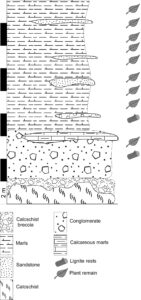
Figure 2. Stratigraphic log of the Stella Santa Giustina geosite.
The MPP geosite is located 2.8 km north of Sassello village (Western Liguria, Savona province) on the road Sassello-Acqui: lat. 44°29’50”, long. 8°29’48”, alt. 353 m a.s.l. (Fig. 1, MPP ). This geosite exhibits coral settlements suffocated by siliciclastic sedimentation. The lithostratigraphic section (thickness about 13 m, Molare Formation; late Rupelian–early Chattian; Fig. 3) rests on the serpentinites of the Voltri Unit and can be sketched as follows (Fravega et al. 1987; Fravega & Vannucci 1987; Quaranta et al. 2009a,b; Bonci et al. 2018; and reference therein): (1) coral framestone and coarse conglomerate with interbedded sandy lenses; besides corals, the fossil content also includes mollusks, bryozoans and very rare larger foraminifera and coralline algae; the first coral colonization was suffocated by coarse to very coarse sediments, that were subsequently colonized by corals; (2) irregular alternation of fine conglomerate and coarse sandstone lenticular beds, in which small to large coral colonies are scattered; besides corals abundant larger foraminifera and coralline algae are present; (3) rhythmic alternation of thin to medium strata of biocalcarenite/hybrid arenite and coral/coralline algae limestone, the fossil content also includes mollusks and larger foraminifera; the coral growth starts from a loose sediment stabilized by encrusting coralline algae. This section records a transgressive event in a warm, shallow infralittoral marine environment and the first coral buildup, that exhibits low relief, and can be interpreted as a rough-water incipient or failed fringing reef (Lorenz 1969; Fravega et al. 1987; Fravega & Vannucci 1987; Quaranta et al. 2009a, b; and reference therein).

Figure 3. Stratigraphic log of the Maddalena–Ponte Prina geosite.
Oligocene Terrestrial Flora and Fauna of Stella Santa Giustina Geosite
The SSG flora (Fig. 4) is composed of Filicopsida, Pinopsida (only small fragments), Magnoliopsida and Liliopsida (for a complete taxonomic list, refer to Bonci et al. 2011), it is one of the most important Oligocene assemblages of Europe, and forms part of the large corpus of the Perrando Collection, property of the Dipartimento di Scienze della Terra, dell'Ambiente e della Vita (DISTAV, Genoa University).
Filicopsida are characterized by the common occurrence of large ferns (mainly Goniopteris polypodioides) and the presence of species of the genus Pteris, Blechnum and Asplenium. As regards Liliopsida, it should be noted the abundance of large Arecaceaen, attributed to the genera Arecites, Cocos, Flabellaria, etc. by Squinabol (1892) and Principi (1921). Magnoliopsida are dominant and very diversified, with abundant Sloanea olmediaefolia and Eotrigonobalanus furcinervis, and less common members of the family Lauraceae and the genus Daphnogene (Hably 2010; Bonci et al. 2011).

Figure 4. Fossil flora from Stella Santa Giustina. A) Goniopteris polypodioides Ettingshausen - 1 -fertile frond. DISTAV Coll. Perrando N. 45/1; scale bar = 1 cm. 2 - sporangia (detail of Fig. 1); scale bar = 1 cm. B) Cocos robustifolia Squinabol - DISTAV Coll. Perrando N. 434/1; scale bar = 1 cm. C) Kydia kraeuseri (Raski) Hably - DISTAV Coll. Perrando N. 277/4; scale bar = 1 cm. D) Daphnogene sp. - DISTAV Coll. Perrando N. 83/3; scale bar = 1 cm. E, Lauraceae gen. et sp. - DISTAV Coll. Perrando N. 247/1; scale bar = 1 cm. F, Sloanea olmediaefolia (Unger) Kvaček & Hably - DISTAV Coll. Perrando N. 243/1; scale bar = 1 cm.
According to Bonci et al. (2011), the proportion of dicotyledonous large leaves reaches 67.71%, suggesting that this flora can be referred to the “tropical basal and premontane belt” of Dolph & Dilcher (1980a, b). This belt was reported to be the tropical life zone below the zone of critical temperature (16–18° C) with an evapotranspiration ratio less than 1.0.
According to Bonci et al. (2011), this paleoclimatic reconstruction is corroborated by the following points: a) the common occurrence of large ferns and large arecaceaens; b) the abundance of taxa restricted to warm climatic conditions (i.e., Sloanea olmediaefolia, Eotrigonobalanus furcinervis, Lauraceae, Daphnogene, Kydia kraeuseli, Acherniaephyllum hydrarchos, Zizyphus zizyphoides, Platanus neptuni, and Engelhardia orsbergensis); c) the mass occurrence of Sloanea olmediaefolia, because the living species of Sloanea are typically distributed in tropical-subtropical areas and the European Paleogene species indicate warm climate (Kvaček et al. 2001); d) the great abundance of very large leaves of Sloanea olmediaefolia associated with common leaves larger than usual (e.g., Eotrigonobalanus furcinervis), that indicate, according to Hably (2007, 2010), a riparian habitat or an environment with abundant water supply; e) the prevalence of untoothed over toothed margined leaves, suggesting tropical climate; f) data on the paleotemperature of the TPB area (Selby 1985; Mosbrugger et al. 2005; Bosellini & Perrin 2007).
In addition, we should note thin pelite beds very rich in Characeae oogonites (among which Nitellopsis (Tectochara) merianii; rare crocodilian and chelonian remains are also present (Lorenz 1969; Quaranta et al. 2009b; Bonci et al. 2011, 2018; and reference therein). The few and fragmented crocodilian and chelonian remains were first described by Issel (1892, 1900). The crocodilian remains are a few teeth and bony fragments, tentatively attributed to ?Crocodylus by Issel (1892). A more definite identification seems impossible because of original poor preservation and more recent damage from flooding of the collections building (Mastrorilli 1970). Among the chelonians, one almost complete carapace has been attributed to Trionyx sp. by Issel (1892), a member of Trionychidae (softshell turtles) that inhabit swamps and wetlands and that went extinct in Europe during the upper Pliocene (Chesi 2008).
In the reconstruction of the SSG geosite paleoenvironment (Fig. 6), there is also an anthracotherid, even if no fossils of this group of amphibious suiform artiodactyls (Anthracotheridae) have been found in the SSG deposits. This has been added because anthracotherids were certainly present in the Oligocene wet areas of the TPB, as documented by abundant finds in the Cadibona area (a village located a few kilometers southeast of SSG) and most likely they also inhabited the wetlands of the SSG area, and because some remains are shown in the permanent exhinbition at Palazzo Gervino (Visitor Center of the Beigua UGGp GeoPark, Sassello). On the fossil materials from Cadibona, Cuvier (1821-1824) erected the genus Anthracotherium and the species A. minimum and A. magnum, and Squinabol (1891a) described the species A. gastaldii.
All these finds, including both fauna and flora and lithotypes, confirm the paleoecological reconstruction of an alluvial plane with lakes, swamps and meandering rivers in tropical climatic conditions.
Oligocene Marine Biota of Maddalena–Ponte Prina Geosite
The MPP geosite has been studied extensively from both a stratigraphic and paleontological perspective (Lorenz 1969; Fravega et al. 1987; Fravega & Vannucci 1987; Quaranta et al. 2009a, b; and reference therein).
The first level of the stratigraphic section is characterized by abundant coral colonies, with mainly massive, encrusting, globular growth morphology, but fragments of branching corals Stylophora are also present. The fossil content also includes mollusk fragments, bryozoans and rare ostracods and foraminifers (rotaliids, miliolids and Nummulites fichteli) and rare coralline algae, which are represented by encrusting-warty thalli of Lithothamnion and/or Phymatolithon (included in the informal, palaeoecological group of melobesiods; for details on the paleoecology of coralline algae, see Singh et al. 2020, with reference therein). The co-occurrence of coral colonies in life position and larger foraminifera indicates warm waters and shallow infralittoral depths (Bosellini & Perrin 2007); this bathymetric allocation is further supported by sedimentological evidence.
The presence of melobesioids could seem anomalous because they commonly occur in deep tropical waters, but they are frequently observed in shallow waters perhaps as a consequence of abiotic and/or biotic factors, e.g. water temperature modified by freshwater input (Piazza 1989; Vannucci et al. 1997), water turbidity caused by hypopycnal flows and/or eutrophication (Vannucci et al. 2003; Wilson 2005, 2008; Brandano et al. 2007), or species autoecology (Piazza 1989; Vannucci et al. 1997).
The second level is characterized by a few scattered coral massive colonies and fragments of branching corals, but also by oysters and pectinids, rare gastropods, echinoid plates and spines, bryozoans and foraminifers (among which rotaliids, miliolids, textulariids, Neoalveolina sp., Heterostegina sp., Amphistegina sp., Operculina complanata, Nummulites fichteli, Nummulites vascus, Eulepidina sp., and rare globigerinids), and coralline algae (as sediment encrusters and rhodolith builders). The coralline alga assemblage is dominated by foliose thalli of Neogoniolithon and encrusting-warty to warty thalli of Spongites (both genera included in the informal palaeoecological group of mastophoroids; Singh et al. 2020). Mesophyllum, Lithothamnion and/or Phymatolithon species (all melobesioids) as well as Lithophyllum species (informal palaeoecological group of lithophylloids; Singh et al. 2020) reach a subordinate position, while Sporolithon (informal, palaeoecological group of sporolithaceans) is rare. The dominance of mastophoroids, the subordinate role of melobesioids and lithophylloids, and the rarity of sporolithaceans indicate a warm, shallow sublittoral paleoenvironment (Singh et al. 2020).
The larger foraminifera provide a chronostratigraphic date for this layer, namely lower Oligocene (Rupelian stage). Recent geochronological dating by Sr isotopes indicates an age of 27.5–28.2 Ma (Briguglio, unpublished data), which points to the upper part of the lower Oligocene, almost including the lowermost part of the upper Oligocene (Chattian stage).
In the third level, the fossil content includes coral colonies, mollusk and echinoid remains, bryozoans, foraminifera (among which lepidocyclinids are very abundant), and coralline algae. The algal assemblage is dominated by mastophoroids (Lithoporella, Neogoniolithon, Spongites), melobesioids (Mesophyllum, Lithothamnion and/or Phymatolithon) are subordinate, lithophylloids (Lithophyllum) and sporolithaceans (Sporolithon) are rare. Corals, larger foraminifera and coralline algae firmly suggest tropical, shallow sublittoral waters. On the whole, the coral fauna comprises mainly massive, encrusting, and globular specimens of Actinacididae (Actinacis), Faviidae (Favia, Colpophyllia, Diploria, Variabilifavia), Meandrinidae (Euphyllia), Merulinidae (Antiguastraea, Hydnophora, Leptoria), Astrocoeniidae (Stylocoenia, Astrocoenia), Acroporidae (Astreopora), Agariciidae (Cyatoseris), Poritiidae (Goniopora) with minor Pocilloporidae branching forms (Stylophora) (Lorenz 1969; Fravega et al. 1987; Quaranta et al. 2009a, b) (Fig. 5). These taxa confirm the paleoenvironmental reconstruction also suggested by the hydrodynamic conditions of the seafloor.

Figure 5. Fossil corals from Maddalena–Ponte Prina. A) Brain coral - DISTAV Coll. Perrando-Prever N. 3746/Cor BTP 472; scale bar = 1 cm. B) Faviidae ind. - DISTAV Coll. Perrando-Prever N. 3721/Cor BTP 448; scale bar = 1 cm. C) Brain coral - DISTAV Coll. Perrando-Prever N. 3682/409; scale bar = 1 cm. D) Colpophyllia stellata (Catullo) - DISTAV Coll. Perrando-Prever N. 3687/414; scale bar = 1 cm. E) Antiguastraea lucasiana (Defrance) - DISTAV Coll. Perrando-Prever N. 3701/428; scale bar = 1 cm.

Figure 6. Paleoenvironmental reconstruction of Stella Santa Giustina geosite. (drawn by F. Boccardo)
The vertebrate fossil content is typical of the proposed paleoenvironment and includes a few shark teeth and fragments of sirenian rib bones. The shark teeth were reported by Issel (1892) but have never been properly studied, whereas the sirenian rests are identified as dugongids, which were quite common in the northern Tethys during the Oligocene (Sagne 2001).
Exceptional Values of the Stella Santa Giustina and Maddalena–Ponte Prina Geosites
The SSG and MPP geosites represent locations of primary importance for the reconstruction of the Oligocene geological and paleoenvironmental evolution of central Liguria–southern Piedmont (Ferrando et al. 2021). The SSG geosite documents ] pre-transgressive terrestrial conditions, while the MPP geosite shows the transgressive event and related shallow marine environments. They are characterized by: strong paleoclimatic and paleoenvironmental significance, because they are excellent examples of subtropical continental wet environments (SSG) (Fig. 6) and marine shallow waters (MPP) (Fig. 7); an abundant and very well-preserved high-diversity fossil content; easy accessibility and good exposure, which facilitate teaching and dissemination activities; to be the source of important historical paleontological collections that include a number of new species types (e.g., Perrando Collection and Prever-Perrando Collection, housed at the DISTAV of Università di Genova and at the Museo Civico di Storia Naturale di Genova); to be studied since the end of the 19th century by eminent geologists/ paleontologists, e.g., Issel (1885, 1892, 1900), Rovereto (1897, 1898, 1900, 1914), Squinabol (1889, 1890, 1891b, c, d, 1892), Prever (1921-1922), Principi (1912, 1914, 1916, 1921).
As regards SSG, similarities can be found with the lower Oligocene fossil floras of Schiavon (Veneto, northern Italy; Principi 1926; Giusberti et al. 2014) and of the Inner Carpathian region (Tard Clay Formation; Hably 2010). These fossil floras, as well as those of SSG, document botanical conditions before the gradual replacement of thermophilic evergreen forests by a temperate, predominantly deciduous vegetation, which occurred across Europe in the late Oligocene. In this context, the high quality and quantity of fossils, the easy accessibility and good exposure of outcrops, and the relevant scientific interest make SSG a geosite of the highest value.


Figure 7. Paleoenvironmental reconstruction of Maddalena–Ponte Prina geosite. (drawn by F. Boccardo)
The Oligocene reefal settlements scattered along the southern margin of the TPB (Lorenz 1969; Quaranta et al. 2009a), those of NE Italy (Geister & Ungaro 1977; Pfister 1980; Frost 1981; Bosellini & Trevisani 1992) and of S Italy (Bosellini & Russo 1992; Bosellini & Perrin 1994) are more or less similar to the MPP geosite, in term of faunal diversity, scientific interest, good preservation of fossils and outcrops. Nonetheless, the MPP geosite is unusual and remarkable because the coral colonization develops on a meta-ophiolitic substrate, so in a single outcrop only a few meters thick, we see the genesis of an ancient (Jurassic) ocean (the ophiolites) and its subduction and tectonic piling (the metamorphism of the ophiolites and their present position in the Ligurian Alps), as well as the subsequent submersion of the orogen by a new sea (the coral reef) and its deepening (the suffocation of corals), and finally the emergence of the entire area by the final stage of orogenic evolution (the present landscape). This aspect makes MPP a geosite of extraordinary value.
Geotourism and Geotrail Potential
The Visitor Center of Palazzo Gervino (Fig. 8), inaugurated in 2008 by Beigua UGGp, houses a fossil collection of inestimable scientific value partly belonging to DISTAV (Università di Genova) and partly to the Municipality of Savona (Poggi et al. 2013). Located in the heart of the historical center of Sassello is the most important showcase of the Geopark and the starting point for several excursions.
The exhibition, spread over several rooms, offers an overview of the Global Geopark Network as well as information, images and curiosities of the extraordinary environmental and historical-cultural heritage of Beigua UGGp through multimedia videos and touchscreen.
Real surprises can be found on the upper floor, where the names of the rooms themselves take us on a "journey back in time" to the Oligocene, 28–30 million years ago, where the important fossil remains from the SSG and MPP geosites are located. The room called "Tropical forest", dedicated to the Oligocene flora of SSG, shows some of the best fossils. Thanks to collaboration with the Department of Culture of the City of Savona, the display offers an exhibition of rare fossil remains of Anthracotherium, among them the holotype of A. gastaldii. The next room called "Corals" shows a paleoenvironmental reconstruction of the coral reef of the MPP geosite and through an exciting graphic design draws the visitor deep into the ancient tropical sea.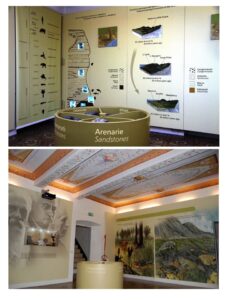
Figure 8. Palazzo Gervino Visitor Center by Beigua UGGp houses a fossil collection of inestimable scientific value. Above the display of the mayor lithotypes of the Sassello area; below the mail exposition room with the paleogeographic reconstructions.
The opening of the Visitor Center of Palazzo Gervino was an important event for the local citizens, until then unaware of the important scientific value of their land, presented after years of work by scientists of the University of Genova. All the initiatives organized over the years to promote the important scientific discoveries have always involved a large number of citizens, interested in knowing the geological heritage of their territory. Ever since its inauguration, the Visitor Center of Palazzo Gervino has always provided free entrance to local citizens of all ages, to promote knowledge and to showcase as much as possible the discoveries and the treasures preserved in the environment that surrounds them.
To promote the fossiliferous MPP geosite, the Geopark guides organize excursions (Fig. 9) and guided tours occasionally inviting university lecturers; such tours have a strong appeal over the whole of Liguria and Piedmont. Visitors, after an introduction at the Visitor Center of Palazzo Gervino, are guided to the fossiliferous MPP geosite in a pleasant walk that allows them to appreciate the landscape context; tourists and hikers are common visitors.
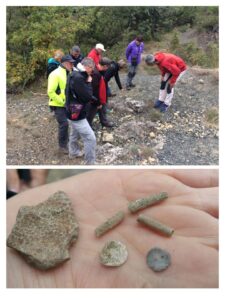
Figure 9. Geotourism at the MPP geosite: excursions and guided tours organized by the Geopark guide to promote the fossiliferous MPP geosite.
Thanks to the guides, tourists are taken on a journey through the geological history of the territory starting back in the Oligocene and are introduced, with simple explanations to the complex, yet fascinating geology. Creating a link between earth science disciplines such as geomorphology, petrography, paleontology and mineralogy and the historical, cultural and, gastronomic traditions, the tourist becomes more conscious of the values of the territory that surrounds him and can experience its special significance.
Within the park, a network has been established among the geosites, through the creation of new hiking trails and panels, including the MPP fossiliferous geosite as the most accessible one, with a geotouristic map (http://www.parks.it/parco.beigua/PDF/Carta_geoturistica_Beigua_Geopark.pdf) distributed free of charge, in accordance with other promotional products of the Geopark, accompanied by geological, topographical and tourist information. The map is rich in illustrations and descriptions to encourage tourists to discover the geosites and the localities that host them.
In addition to promoting geotourism, another important institutional mission of the Beigua UGGp is environmental education. Thanks to the special projects studied, promoted and carried out by the Geopark guides, many activities are implemented with schools of all levels, even outside Liguria, with an increasing number of interested institutes (Fig. 10). For this reason, the MPP and SSG fossiliferous geosites offer an incredible reservoir of ideas for projects related to geodiversity for all school levels. The theme of paleontology for children suggests past times in which dinosaurs and big winged reptiles lived, and just starting from their passions we address more complex geological issues. For older scholars, it is possible to address more challenging topics related to paleontology, geodynamics and petrography.
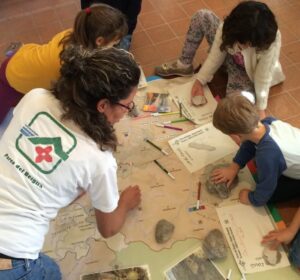
Figure 10. Geoeducation activities: environmental educational activities to promote geotourism with schools of all levels.
The conservation of important geological evidence emerges, in particular, in the MPP geosite as a very delicate and important issue. Over the years, different valorization projects have been carried out, mainly through panels and road signs. At present, a geosite requalification and valorization project is in progress: it involves environmental engineering works, to reduce surface water runoff in the most critical areas, as well as cleaning the outcropping fossil remains to make them more visible.
The Beigua UGGp, actively involved at an international level in many projects, also collaborates in numerous national and international events, such as the Science Festival, Planet Earth Week, International Day for the Reduction of Natural Risks, promoting the discovery of their geosites. All these activities and initiatives are widely promoted on the Beigua UGGp website (www.parcobeigua.it), on the Facebook page "Parco del Beigua", on Twitter, Instagram, Telegram, YouTube channel and on the geopark newsletter.
Conclusion
Some of the most interesting palaeontological heritage of the Liguria Region is located in the Beigua UGGp (Brancucci et al. 2004), which is characterized by high geodiversity and its suitability for geotourism, thanks to the activities organized by the Geopark. The SSG and MPP geosites show a broad range of the geology of central Liguria–southern Piedmont, and especially for reconstruction of key events in the Oligocene, when the humid, tropical forests were flooded by shallow seas. The older geological history, represented by ophiolites beneath the sedimentary succession, demonstrate the presence of a Jurassic ocean associated with subduction along the north Tethyan margin and piling up of seafloor sediments.
The good exposure and easy accessibility of the MPP geosite greatly facilitates teaching and dissemination activities with schools and hiking groups. The actions of Beigua UGGp, by encouraging tourism, educational and didactic activities (geotourism) and conservation and enhancement interventions (geoconservation) are fundamental in enhancing the potential of the territory, promoting its knowledge and increasing the economic and social development of local communities.
Acknowledgments
We acknowledge all research projects that have contributed to sustaining research in the Geopark over the years: 100022-2018-MP-FFABR_002-Piazza and 2017RX9XXY_002-Briguglio funded by the Italian Minister of University and Research, and 100022-2019-FRA_Piazza and 100022-2018-AB-CURIOSITY_001-Briguglio funded by the University of Genova, Italy. This paper has greatly profited from critical reading and suggestions by Dan Grigorescu (Bucharest University) and three anonymous reviewers
Conflict of Interest
We have no conflicts of interest to disclose.
